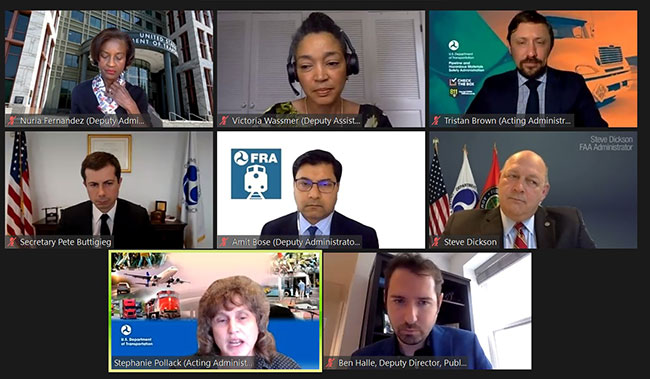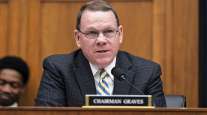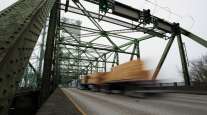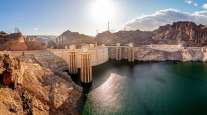Staff Reporter
Biden’s Budget Includes Boost for Transportation Purposes

[Stay on top of transportation news: Get TTNews in your inbox.]
President Joe Biden has unveiled a whopping $6 trillion budget proposal that includes billions for provisions to boost transportation infrastructure.
During a press conference, Transportation Secretary Pete Buttigieg said the proposal covers subjects that have a lot of “sizzle,” such as automation technology, along with topics that may be considered “unsexy” but that he said are “profoundly important.”
“An improvement in the longevity of pavement of just a few percent would have multibillion[-dollar] annual implications for state, local and federal budgets everywhere,” Buttigieg said during the May 28 virtual session.
Today, I released my budget for the upcoming fiscal year. It builds on the progress we’ve made over the last few months and makes historic investments that will help our nation build back better for decades to come. Read more here: https://t.co/6dKv8wa4yI — President Biden (@POTUS) May 28, 2021
The budget, proposed for fiscal 2022 spending, must now be considered by Congress, which actually sets the budget.
According to the U.S. Department of Transportation, Biden’s proposal reflects an $88 billion investment in transportation. Victoria Wassmer, deputy assistant secretary for finance and budget at DOT, explained this figure reflects a combination of mandatory resources and discretionary resources.
Biden’s budget proposal outlined a discretionary request of $25.7 billion for DOT, which represents a 14.8% increase for the agency’s discretionary programs. Mandatory funding has traditionally been provided through surface authorization acts.
In a document detailing the budget’s highlights, DOT said:
- Some $675.8 million was requested for the Federal Motor Carrier Safety Administration. Some $288 million of that represents the request for administrative expenses, information technology and research, while $388 million was requested for FMCSA grant programs. In an effort to prepare for the next generation of vehicles, FMCSA plans to conduct research to support the development of regulations, procedures and guidance for roadside inspectors regarding inspecting electric trucks and responding to electric truck crashes.
- Some $1 billion was requested for the Rebuilding American Infrastructure with Sustainability and Equity (RAISE) grant program, which was known as Better Utilizing Investments to Leverage Development (BUILD) during the Trump administration and Transportation Investment Generating Economic Recovery (TIGER) during the Obama administration.
- For the National Highway Traffic Safety Administration, $1.02 billion was requested. Some $623 million was requested for highway traffic safety grants, which NHTSA awards to state and local governments to improve safety on roadways.
- The request for the Federal Highway Administration totaled $47.1 billion. Some $2.5 billion of that amount was requested for the Congestion Mitigation and Air Quality Improvement Program and $1.5 billion was requested for infrastructure and operational improvements on the national highway freight network.

Transportation officials outline the budget proposals. (U.S. Department of Transportation)
The budget proposed $2.5 billion for Capital Investment Grants to expand access to transit. The request included $250 million in grants for transit agencies to purchase low- and zero-emission buses. It also outlined $625 million for a new Passenger Rail Improvement, Modernization and Expansion grant program, as well as $375 million for Consolidated Rail Infrastructure and Safety Improvements grants.
Randy Mullett, senior policy adviser for the National Industrial Transportation League, said the organization has concerns about the focus on high-speed passenger rail.NITL is a trade association representing shippers in the rail, maritime and highway sectors.
“If you add more passenger trains and more transit on existing freight rail lines, it has the potential to reduce capacity of freight rail, and we’re really concerned about that,” Mullett told Transport Topics. “When utilizing the same infrastructure, you’re competing for that space.”
Addressing climate change was one of the major goals listed in the budget proposal, which puts forth a slew of investments meant to reduce emissions.
Some $600 million was requested for electric vehicles (EVs) and charging infrastructure in the individual budgets of 18 federal agencies, including dedicated funds at the General Services Administration and for the United States Postal Service.
Biden has outlined a goal to build a network of 500,000 EV chargers by 2030. To reach this goal, his plan proposes rebates for EVs as a way to urge consumers to buy zero-emission vehicles.
The budget proposal must now be considered by Congress, and representatives of the contracting industry stressed the importance of bipartisan solutions. Peter Comstock, senior director of legislative affairs for Associated Builders and Contractors, expressed opposition to the tax policies outlined in the budget proposal, stating they would be detrimental to contractors.
“The budget takes unprecedented steps in promoting tax credits that would support the enforcement of discriminatory labor standards and one-size-fits-all apprenticeships for the construction industry,” Comstock said. “Like all presidential budgets, the Biden budget is merely a wish list, and ABC urges the president to work with Congress to enact bipartisan agreements that will promote our nation’s entire construction industry and allow our small businesses to thrive as we continue to recover from the COVID-19 pandemic.”
Brian Turmail, vice president of public affairs and strategic initiatives at the Associated General Contractors of America, said the group is reviewing the proposal closely.
“On first glance, it is encouraging to see significant new investments in infrastructure,” Turmail said. “But, as we have seen with the president’s prior proposals, those new investments tend to come with a lot of strings that could undermine some of the benefits of those new investments. Our goal remains to work with the administration and Congress to pursue enactment of new bipartisan infrastructure investments.”
Want more news? Listen to today's daily briefing below or go here for more info:




